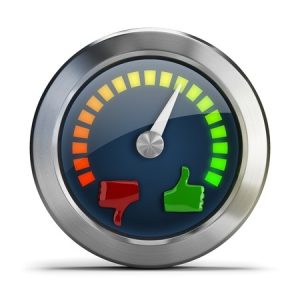People are measuring lots of things nowadays, and in fact there is a growing industry of devices and software for personal measurement. But despite the onslaught of technology to measure ourselves, we may not be thoughtful enough about which measurements really matter to achieving our personal and business goals.
Choosing which measurements are meaningful can be tougher than it may appear on the surface. Often, we measure the wrong things and assume we are gleaning valuable information. Take the Fitbit(tm) and similar activity trackers. In our personal quest for fitness, we measure how many steps a day we take. But this can be misleading. Say, for example, you are a jogger and average 3 miles a day of exercise. If you measure that in steps, then you likely fulfill your step allotment every day just in that half an hour. But if you really are committed to reducing the poor health outcomes associated with leading a sedentary life, you are doing far too little – or too much in too short a time span. The answer isn’t to jog more, but to measure (for instance) how frequently you move during the course of the day. If your only burst of activity is 30 minutes of jogging and you sit for the rest of the day, your Fitbit is not helping you to achieve your goals.
In business we see similar conflations of measurements. Call centers regularly measure the average length of time for a support call. On the surface that seems like a great way to gauge the productiv ity of an operator. But when you look under the hood, failing to correlate that number with the satisfaction of callers, or the number of times an individual calls back for the same problem means you are getting insufficient information to determine productivity. After all, if a customer calls back 4 times for the same issue, then even though each call averages the targeted (say) 2 minutes – the total time and resources required to solve the problem was really 8 minutes and 3 add-on calls – each with its own individual price tag. Moreover, when we measure thoughtlessly we can cause unintended consequences. In the call center scenario, one typical outcome of that metric is that operators escalate calls to a manager just to get off the phone – and the cost of a manager’s time is greater than an operator. Ironically, forcing operators to keep calls short then increases the cost per call. So this business of measurement can be a pretty complex puzzle. If we really want to know whether our call center operators are effective we need a variety of measurements and a way of understanding their relationships to each other.
ity of an operator. But when you look under the hood, failing to correlate that number with the satisfaction of callers, or the number of times an individual calls back for the same problem means you are getting insufficient information to determine productivity. After all, if a customer calls back 4 times for the same issue, then even though each call averages the targeted (say) 2 minutes – the total time and resources required to solve the problem was really 8 minutes and 3 add-on calls – each with its own individual price tag. Moreover, when we measure thoughtlessly we can cause unintended consequences. In the call center scenario, one typical outcome of that metric is that operators escalate calls to a manager just to get off the phone – and the cost of a manager’s time is greater than an operator. Ironically, forcing operators to keep calls short then increases the cost per call. So this business of measurement can be a pretty complex puzzle. If we really want to know whether our call center operators are effective we need a variety of measurements and a way of understanding their relationships to each other.
In business, questions of what to measure and what those measurements tell you can only truly be resolved deep in the heart of our strategies. This reality starts with a simple fact about measuring processes and outcome: Measurements can be applied to two broad categories, leading and lagging indicators. Lagging indicators aren’t terribly revealing if your goal is to impact the result. Depending on them is like counting on the scoreboard to hone your soccer skill. It is a report on the past, not an alert about the future. So if Belgium and the US soccer teams play a match and the final score is 5-2 to Belgium, all you know is that the US lost. As a coach that information is virtually irrelevant to your actual work.
On the other hand, leading indicators offer predictive knowledge about how to change the end-result. For example, if in the first period of play, the Belgian team is shooting on goal three times more than the US, then it’s a good bet that they will score more frequently. Shooting at the goal is a necessary step in scoring. And if you don’t shoot frequently enough, you miss out on tons of opportunities to get goals. Why does this distinction matter? Because you can work on shooting more frequently. You can’t “work” on winning.
In strategy we seek to determine what exact processes will lead to desired business outcomes. In other words, we are looking for cause and effect relationships. When we find those relationships, we gain a road map for where to put energy. For example, we might have a sales funnel process that breaks down into 3 or 4 distinct stages. Each stage of the process moves the prospective customer onto the next stage or out of the funnel. In sales, we train new sales people in filling a funnel by prospecting, qualifying, presenting, negotiating and closing. By measuring each of these stages, we gain understanding and knowledge that will ultimately allow us to determine the “final score”, a lagging indicator. That lagging indicator is the total sales completed. When new sales people are first scolded for making too few cold calls, they learn this logic. Cold calls create leads, leads create prospects, and prospects become customers. It’s a series of cause and effect relationships. Simple. So why don’t we apply that same logic to our solopreneurial enterprises or to our health or weight loss.
I speak to lots of entrepreneurs who suffer for lack of new clients. Yet they never apply this kind of process thinking to their own work. You are unlikely to find new clients by simply attending networking events. You need a measurable, cause and effect process to transform casual, appetizer chit-chat into new customers. And whatever that process is, you need to measure it along the way so you can distinguish the sources of success and failure when you look at your actual results. Without leading indicators your final result is always somehow divorced from the steps you took. It leaves you powerless and feeling like providence is determining your income instead of you. When you craft a process and measure the contributing steps along the way you can diagnose problems and fix them in advance of the disappointment. If you have an idea how many prospects you called, how many you made proposals to and what percentage became clients, then you gain control over the end result. Wouldn’t it be worth knowing that the wheels usually fall off sometime between a lunch meeting and a proposal? That insight provides something to work on improving.
We do the same thing in our personal goals. I know so many people trying to lose weight. But trying to lose weight is like trying to make money. It isn’t something you work on. The number on the scale is a lagging indicator. It tells you about the past, not about the future. What leading indicators could you measure – metrics that would give you real information about what the scale might say tomorrow? Well, you could track your food intake and know your total calories and nutrition breakdown each day. You could track your exercise, including frequency, duration and intensity – and measure how many calories you are burning. Those are pretty easy to measure without any special equipment beyond a free app. You could keep going in quantifying more and more – and certainly there is a diminishing rate of return on adding more measurements. But with few or no leading indicators, you are expecting to lose weight on the basis of hope alone.
Obviously, most of us understand the causes of weight loss or gain, and the basics of a sales cycle. But in your business and life there are areas with less obvious causal mechanics. They can seem like mysteries. Why do we have such high employee turnover? Why don’t we get referrals? Why is our cash flow so poor? These questions require more significant thought and consideration. There may not be a single, obvious answer, and instead a strategy is needed to test possible explanations and solutions. But testing can only happen if you measure both leading and lagging indicators – or at least what you speculate are the leading indicators. So consider approaching a single current business challenge this way.
- Articulate the business challenge clearly. For example: “Our clients don’t pay on time”.
- Determine the lagging indicator (e.g., average days to payment).
- Try to speculate about what process would lead to the desired outcome (e.g., 30 days net payment).
- Document the process in specific, discrete steps (Clarify the payment terms while still in the contract phase. Send an invoice 10 days in advance of due date. Send reminders. Call on day 31 to follow-up… and so forth).
- Begin measuring every step of the process
- Keep it up and watch what happens!
Once you start seriously pondering where cause and effect relationships exist, the question of what to measure becomes far clearer. You measure as many causes as you can so that you can affect each one. As you develop this muscle, lagging indicators become less surprising. In fact, they become predictable. And here’s the coolest part: If you were to measure the accuracy with which you can predict the “final score”, you would discover that measurement of predictability is like its own little lagging indicator — of your own power.
Are you interested in having extraordinary results? Contact me to schedule a complimentary consultation and learn how a measurable, cause and effect-based strategy could transform your business!





Comments
Pingback: A Wobbly Waterfall – Measurement – Som2ny Network